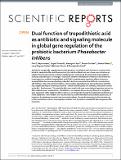| dc.contributor.author | Beyersmann, Paul G. | |
| dc.contributor.author | Simon, Meinhard | |
| dc.contributor.author | Brinkhoff, Thorsten | |
| dc.contributor.author | Tomasch, Jurgen | |
| dc.contributor.author | Goker, Markus | |
| dc.contributor.author | Wagner-Dobler, Irene | |
| dc.contributor.author | Son, Kwangmin | |
| dc.contributor.author | Stocker, Roman | |
| dc.date.accessioned | 2017-06-16T19:51:22Z | |
| dc.date.available | 2017-06-16T19:51:22Z | |
| dc.date.issued | 2017-04 | |
| dc.date.submitted | 2016-11 | |
| dc.identifier.issn | 2045-2322 | |
| dc.identifier.uri | http://hdl.handle.net/1721.1/109983 | |
| dc.description.abstract | Antibiotics are typically regarded as microbial weapons, but whereas their function at concentrations lethal for bacteria is often well characterized, the role of antibiotics at much lower concentrations as possibly found under natural conditions remains poorly understood. By using whole-transcriptome analyses and phenotypic screenings of the marine bacterium Phaeobacter inhibens we found that the broad-spectrum antibiotic tropodithietic acid (TDA) causes the same regulatory effects in quorum sensing (QS) as the common signaling molecule N-acyl-homoserine lactone (AHL) at concentrations 100-fold lower than the minimal inhibitory concentration against bacteria. Our results show that TDA has a significant impact on the expression of ~10% of the total genes of P. inhibens, in the same manner as the AHL. Furthermore, TDA needs the AHL associated LuxR-type transcriptional regulator, just as the AHL molecule. Low concentrations of antibiotics can obviously have a strong influence on the global gene expression of the bacterium that produces it and drastically change the metabolism and behaviour of the bacterium. For P. inhibens this includes motility, biofilm formation and antibiotic production, all important for settlement on new host-associated surfaces. Our results demonstrate that bacteria can produce antibiotics not only to antagonise other bacteria, but also to mediate QS like endogenous AHL molecules. | en_US |
| dc.language.iso | en_US | |
| dc.publisher | Nature Publishing Group | en_US |
| dc.relation.isversionof | http://dx.doi.org/10.1038/s41598-017-00784-7 | en_US |
| dc.rights | Creative Commons Attribution 4.0 International License | en_US |
| dc.rights.uri | http://creativecommons.org/licenses/by/4.0/ | en_US |
| dc.source | Nature | en_US |
| dc.title | Dual function of tropodithietic acid as antibiotic and signaling molecule in global gene regulation of the probiotic bacterium Phaeobacter inhibens | en_US |
| dc.type | Article | en_US |
| dc.identifier.citation | Beyersmann, Paul G.; Tomasch, Jürgen; Son, Kwangmin; Stocker, Roman; Göker, Markus; Wagner-Döbler, Irene; Simon, Meinhard and Brinkhoff, Thorsten. “Dual Function of Tropodithietic Acid as Antibiotic and Signaling Molecule in Global Gene Regulation of the Probiotic Bacterium Phaeobacter Inhibens.” Scientific Reports 7, no. 1 (April 2017): 730 © 2017 Macmillan Publishers Limited, part of Springer Nature | en_US |
| dc.contributor.department | Massachusetts Institute of Technology. Department of Civil and Environmental Engineering | en_US |
| dc.contributor.department | Massachusetts Institute of Technology. Department of Mechanical Engineering | en_US |
| dc.contributor.mitauthor | Son, Kwangmin | |
| dc.contributor.mitauthor | Stocker, Roman | |
| dc.relation.journal | Scientific Reports | en_US |
| dc.eprint.version | Final published version | en_US |
| dc.type.uri | http://purl.org/eprint/type/JournalArticle | en_US |
| eprint.status | http://purl.org/eprint/status/PeerReviewed | en_US |
| dspace.orderedauthors | Beyersmann, Paul G.; Tomasch, Jürgen; Son, Kwangmin; Stocker, Roman; Göker, Markus; Wagner-Döbler, Irene; Simon, Meinhard; Brinkhoff, Thorsten | en_US |
| dspace.embargo.terms | N | en_US |
| dc.identifier.orcid | https://orcid.org/0000-0002-8886-7455 | |
| dc.identifier.orcid | https://orcid.org/0000-0002-3199-0508 | |
| mit.license | PUBLISHER_CC | en_US |
| mit.metadata.status | Complete | |
